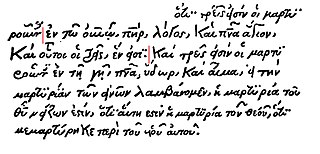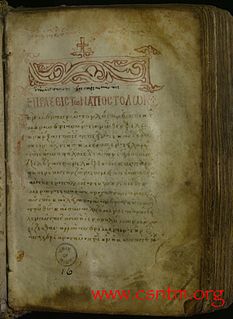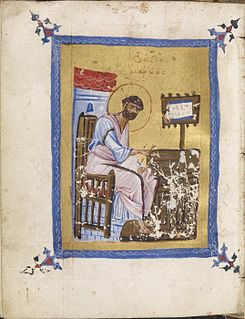| New Testament manuscript | |
| Text | Catholic epistles, Pauline epistles |
|---|---|
| Date | 12th/13th century |
| Script | Greek |
| Now at | University of Uppsala |
| Size | 23 cm by 17 cm |
| Type | Alexandrian text-type |
| Category | II |
Minuscule 442 (in the Gregory-Aland numbering), O18 (in the Soden numbering), [1] is a Greek minuscule manuscript of the New Testament, on parchment. Palaeographically it has been assigned to the 12 or 13th century. [2] Formerly it was assigned by 68a and 73p. It shared all these designations with Minuscule 441, with which it now comprises a single codex.
The codex contains the text of the Catholic epistles and 1 Corinthians 13:6 to Hebrews 13:25 of the Pauline epistles on 129 parchment leaves (23 cm by 17 cm). It is written in one column of 38-39 lines per page. [2]
It contains the Euthalian Apparatus, subscriptions at the end of each book, στιχοι , and four prolegomena to the Hebrews. The biblical text is surrounded by a catena of Oecumenius. [3] [4]
Leaves 3-182 form another manuscript which is now bound in the same codex. These leaves have a duplicate portion (1 Cor 13:6-15:38) and some contradictory readings. [3] Now they are classified as Minuscule 441. [2]
The Greek text of the codex is representative of the Alexandrian text-type with some alien readings. Aland placed it in Category II. [5] It is one of the witnesses of the textual variant ὃς ἐφανερώθη (he was manifested) in Timothy 3:16. This reading is supported by such Alexandrian manuscripts as Codex Sinaiticus, Codex Alexandrinus, Codex Ephraemi, Minuscule 33, Minuscule 225, and Minuscule 2127, but it is also confirmed by the manuscripts of the Western text-type like Codex Augiensis and Codex Boernerianus. [6]
In 1 John 5:6 it has the textual variant δι' ὕδατος καὶ πνεύματος καὶ αἵματος (through water and spirit and blood) together with these manuscripts and versions: Codex Porphyrianus, 81, 88, 630, 915, 2492, arm, eth. [7] [n 1] Bart D. Ehrman identified this reading as Orthodox corruption. [8]
The codex was bought at Venice (along with Minuscule 441 and Minuscule 899) by Johan Gabriel Sparwenfeld in 1678. [4] [3]
Peter Fabian Aurivill published facsimile of two fragments of the codex (with text of the Acts 10:34-38 and 1 Timothy 3:16). [9] It was examined by Adolf Michaelis, [10] and Johannes Belsheim. Caspar René Gregory saw it in 1891. [4]
The manuscript was added to the list of the New Testament manuscripts by Scholz (1794-1852). [11]
Formerly it was labelled by 68a and 73p. [4] In 1908 Gregory gave the number 442 to it. [1]
The codex is cited in critical editions of the Greek New Testament (NA26). [12]
It is currently housed at the University of Uppsala (Gr. 1, p. 183-440) in Uppsala. [2]

Codex Montfortianus designated by 61, and known as Minuscule 61 is a Greek minuscule manuscript of the New Testament on paper. Erasmus named it Codex Britannicus. Its completion is dated on the basis of its textual affinities to no earlier than the second decade of the 16th century, though a 15th-century date is possible on palaeographic grounds. The manuscript is famous for including a unique version of the Comma Johanneum. It has marginalia.
Minuscule 81, or α162 is a Greek minuscule manuscript of the New Testament, on a parchment. It is dated by a colophon to the year 1044. Formerly it was labelled by 61a and 61p (Gregory). The manuscript is lacunose. It was adapted for liturgical use.

Minuscule 876 α 356 (Soden). It is a Greek minuscule manuscript of the New Testament, on 282 parchment leaves. It is dated paleographically to the 12th century. Formerly it was labelled by 224a and 279p. Scrivener labelled it by 221a.

Minuscule 700, ε 133 (Soden), is a Greek minuscule manuscript of the Gospels. Formerly it was labelled as 604 in all catalogues, Gregory gave the number 700 to it. It is dated palaeographically to the 11th century.
Uncial 0150 (in the Gregory-Aland numbering), X2 (in the Soden numbering), is a Greek uncial manuscript of the New Testament. It is dated paleographically to the 9th century.

Minuscule 1424, δ 30 is a Greek minuscule manuscript of the New Testament, written on 337 parchment leaves. It has been dated paleographically to the 9th or 10th century).
Minuscule 103, ΟΘ28 (Soden), is a Greek minuscule manuscript of the New Testament, on parchment leaves. Palaeographically it has been assigned to the 12th century. The manuscript has complex contents.

Minuscule 104, α 103 (Soden), is a Greek minuscule manuscript of the New Testament, on parchment leaves. Palaeographically it has been assigned to the 11th century.
Minuscule 175, δ 95 (Soden), is a Greek minuscule manuscript of the New Testament, on parchment. Palaeographically it has been assigned to the 12th century. It has marginalia.
Minuscule 206, α 365 (Soden), is a Greek minuscule manuscript of the New Testament, partly on parchment, partly on paper. Palaeographically it has been assigned to the 15th century.

Minuscule 314 (in the Gregory-Aland numbering), O11 (Soden), is a Greek minuscule manuscript of the New Testament, on parchment. Palaeographically it has been assigned to the 11th century. Formerly it was labelled by 23a, 28p, and 6r.
Minuscule 326, α 257 (Soden), is a Greek minuscule manuscript of the New Testament, on parchment. Paleographically it has been assigned to the 10th century. Formerly it was labelled by 33a and 39p . It was prepared for liturgical use.
Minuscule 400, δ 50 (Soden), is a Greek minuscule manuscript of the New Testament, on parchment. Palaeographically it has been assigned to the 12th century.
Minuscule 424, Ο12, is a Greek minuscule manuscript of the New Testament, on parchment. Palaeographically it has been assigned to the 11th century. Formerly it was designated by 66a and 67p.
Minuscule 440, δ 260, is a Greek minuscule manuscript of the New Testament, on parchment. Palaeographically it has been assigned to the 12th century. The marginal equipment is almost complete.
Minuscule 441 (in the Gregory-Aland numbering), O18 (in the Soden numbering), is a Greek minuscule manuscript of the New Testament, on parchment. Palaeographically it has been assigned to the 13th century. Its former designations were 68a and 73p.
Minuscule 463, is a Greek minuscule manuscript of the New Testament, on parchment. Palaeographically it has been assigned to the 12th century. Formerly it was labeled by 103a and 118p.
Minuscule 918, O 66, is a 16th-century Greek minuscule manuscript of the New Testament on paper, with a commentary. The manuscript is famous for the Comma Johanneum.
Minuscule 911 (in the Gregory-Aland numbering), O29 (von Soden), is a 12th-century Greek minuscule manuscript of the New Testament with a commentary on parchment.
Minuscule 916, Οπρ20, is a 12th-century Greek minuscule manuscript of the New Testament on parchment. The manuscript has not survived in complete condition.